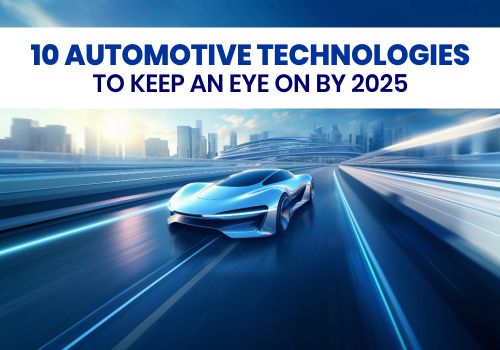
As we speed into 2025, the car world is changing at a blistering pace. From electric drivetrains to AI-powered systems, innovation has been ushering vehicles into an age once close to science fiction. Whether you are a city commuter, a rural tractor operator, or a tech-savvy car enthusiast, these coming technologies will shape how we drive, travel, and even farm. So here’s a chance to look at the top 10 automotive technologies to watch in 2025.
Solid-State Batteries
In light of this, solid-state battery technology has the potential to transform EVs with higher energy density than traditional lithium-ion batteries, faster charging times, and enhanced safety. This tech is getting significant investment from automakers such as Toyota and BMW, with the first commercial models due in 2025. Sustainable solid batteries also show potential for having electric-powered tractors that run for longer durations and work better for rugged farm jobs.
Driveless Driving Systems (Category 4)
While self-driving cars (Level 5) are years away, Level 4 autonomy, allowing a car to drive itself in certain circumstances, is expected to be more common by 2025. Firms such as Waymo and Tesla are improving their AI systems for complex environments ranging from city streets to highway cruising. The concept of autonomy is also being applied to the agricultural sector, and companies have started testing self-driving tractors for precision farming.
Vehicle-to-Everything (V2X) Communication
Using V2X technology, it becomes possible for vehicles to communicate with one another, the infrastructure, and even pedestrians. It makes the transportation system safer by notifying drivers of potential accidents or optimizing the flow of traffic. Widespread deployment of V2X, particularly in smart cities, will occur in 2025. Connected tractors and ag vehicles will work with drones and sensors to improve productivity in rural regions.
Augmented Reality Dashboards
Heads-up displays (HUDs) aren’t new, but augmented reality (AR) will take them to the next level in 2025. Picture driving-navigation alerts superimposed on your windshield, instructors about which lane to be in, which exit to take, or hazards to avoid in real time. It’s not just cars in AR systems — some premium tractors and construction machines are also turning to AR for more productive fieldwork and machine operation.
DMS — Advanced Driver Monitoring Systems
Driver monitoring systems are quickly becoming a legal requirement in many areas, with driver fatigue and driver distraction being responsible for a significant number of road accidents. Its DMS will serve as a warning system, using eye-tracking, facial recognition, and biometric sensors to spot a driver about to drift off before it’s too late. For commercial or agricultural vehicles such as tractors, these systems can ensure drivers stay attentive during long hours of operation.
Software Updates Over-the-Air (OTA)
No longer does a vehicle have to be taken to a service center for updates to its software. OTA technology enables manufacturers to send updates directly to their vehicles, improving performance, fixing bugs, or adding new features without needing to move cars to service bays. Tesla first broke this ground, but by 2025, it will be deploying OTA capabilities to extend vehicle life and functionality to just about every major carmaker, not to mention makers of smart tractors.
Personalization and Biometric Access
Farewell to conventional car keys. Automobiles in 2025 will rely heavily on biometric systems such as fingerprint readers, facial recognition, and even voice activation for entry and personalization. These attributes provide user-friendly, as well as improved, security aspects. Some of the same technology is coming to high-end tractors, equipping drivers to start up and set with personalized preferences the various tractors they drive through their biometric profiles.
Green Hydrogen Fuel Cells
Battery electric vehicles are all the rage, but hydrogen fuel cells are appealing because you can refuel the car quickly, and they can go a long distance. Commercial vehicles, such as trucks and tractors, will be available in certain markets with mature fueling infrastructure starting in 2025. In such sectors, the change could substantially lower emissions.
Artificial Intelligence-Driven Predictive Maintenance
Artificial intelligence is rising as a leader in the field of vehicle diagnostics. Predictive maintenance systems employ sensors and machine-learning algorithms to identify potential issues before they lead to a major failure. This, in turn, saves downtime and repair costs for both personal and commercial vehicles. For a business that operates food processing equipment, such as tractors, it means the machinery can continue to run and maintenance schedules to be optimized.
3D-Printed Automotive Parts
The automotive supply chain is being revolutionized with 3D printing, also known as additive manufacturing. In 2025 3D printed parts will be used by automakers from prototyping to on-demand production and customization. For farmers and mechanics, the ability to print a broken tractor part on the spot could have meant quicker fixes and less reliance on sometimes stretched supply chains.
Conclusion
The car business is in the midst of one of the most radical shifts in the history of the auto industry. Science fiction is becoming reality as previously “impossible” technologies are created that improve safety, performance, and environmental stewardship. Whether you’re buzzing around the city in an electric SUV or farming on a smart tractor in the countryside, 2025 will herald a revolutionary new era in mobility. Keep an eye on these developments –they’re not just changing the way we get around but the way we live and work in an interconnected world.